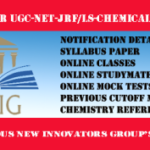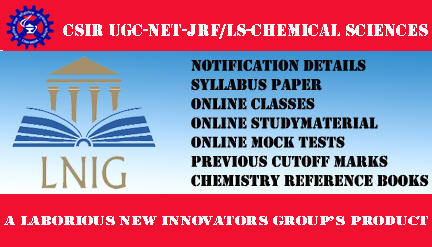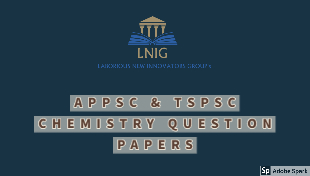Instructor Details
More Courses by LNG CHEMICAL SCIENCES.
Objective Physical Photochemistryby LNG CHEMICAL SCIENCES.
Objective Coordination Chemistryby LNG CHEMICAL SCIENCES.

APPSC GOVERNMENT DEGREE COLLEGE LECTURERS CHEMISTRY ONLINE MOCK TESTSby LNG CHEMICAL SCIENCES.

CSIR UGC NET CHEMICAL SCIENCES ONLINE MOCK TESTSby LNG CHEMICAL SCIENCES.
AP POLICE CHEMICAL SCIENTIFIC ASSISTANTby LNG CHEMICAL SCIENCES.






Hyper conjugation effect and its applications:
1. Hyper conjugation effect and its applications – Introduction, Definition, Examples, comparison with conjugation, structural requirements in a molecule to show Hyperconjugation, Bonding in Hyperconjugation, Important Postulates, Baker and Nathan effect, Classification – Sacrified Hyperconjugation, Isovalent Hyperconjugation, Reverse Hyperconjugation – Class video:
Hyper conjugation – Topics covered:
• Hyper conjugation – Learning outcomes.
• Hyper conjugation – Introduction.
• Hyper conjugation – Definition:
• Hyper conjugation – Examples:
• Comparison between conjugation and Hyper conjugation.
• Hyper conjugation – Requirements.
• Hyper conjugation – Bonding.
• Hyper conjugation – Important Postulates.
• Hyper conjugation – Baker and Nathan effect.
• Hyper conjugation – Classification.
1. Sacrified Hyper conjugation.
2. Isovalent hyper conjugation.
3. Reverse Hyper conjugation.
• Hyper conjugation – Consequences and Applications.
1. Hyper conjugation explains stability of olefins.
2. Hyper conjugation explains stability of carbocations (carbonium ions).
3. Hyper conjugation explains stability of free radicals.
4. Hyper conjugation explains stability of alkyl benzene.
5. Hyper conjugation explains stability of carbonyl group.
6. Hyper conjugation explains stability of heat of hydrogenation.
7. Hyper conjugation explains Dipole moment & bondlength.
8. Hyper conjugation explains Reactivity and orientation of electrophilic substitution on benzene ring.
9. Hyper conjugation explains Anomeric effect.
• Hyper conjugation – Summary.
Hyper conjugation – Learning outcomes: After studying this Hyperconjugation concept, you shall be able to understand the concept of Hyperconjugation – Introduction, Definition, Examples, comparison with conjugation, structural requirements in a molecule to show Hyperconjugation, Bonding in Hyperconjugation, Important Postulates, Baker and Nathan effect, Classification – Sacrified Hyperconjugation, Isovalent Hyperconjugation, Reverse Hyperconjugation and Learn about the important consequences and applications of Hyperconjugation.
Hyper conjugation – Introduction: In conjugation, we have studied that the electrons move from one p orbital to other which are aligned in parallel planes. Is it possible for electron to jump from p orbital to sp3 orbital that are not parallelly aligned with one another? The answer is yes. This type of conjugation is not normal, it is extra-ordinary. Hence, the name Hyper-conjugation. It is also know as no-bond resonance. Let us study more about it.
Comparison between conjugation and Hyper conjugation: In conjugation the electrons get delocalized in p orbitals, but in Hyper conjugation electrons get delocalized in p orbitals, Hence this is an extension of normal conjugation and was termed Hyperconjugation.
Hyper conjugation – Definition: The conjugation or delocalization of - bonded electrons of a C – H bond, towards adjacent – electrons or adjacent carbon atom having empty orbital or incompletely filled – orbital or anti bonding – orbital is called as Hyper conjugation.
Hyper conjugation – Examples:
Hyper conjugation in Propene:
Hyper conjugation – Requirements: There must be an α-C-H group or a lone pair on atom adjacent to sp2 hybrid carbon or other atoms like nitrogen, oxygen etc. E.g., Alkenes, alkyl carbocations, alkyl free radicals, nitro compounds with α- hydrogen. Due to the presence of hydrogen on the - carbon (which is next to the multiple bond) displacement of -electrons towards the multiple bond takes place which causes the polarization of the multiple bond.
Bonding in Hyper conjugation: In Hyper conjugation, bonding is explained as an overlap of the σ orbital of the C-H bond and the π orbital of C-C bond, analogous to the π-π orbital overlap. For example, in propene, the delocalization of -electrons of C-H bond of methyl group occurs into the p-orbital of doubly bonded carbon which is shown below.
In Hyper conjugation, canonical forms can be drawn involving sigma electrons of C –H bond. In such canonical forms there is no presence of any covalent bond at all between the Carbon and Hydrogen. Hence, Hyperconjugation is also known as No Bond Resonance or low-order resonance effect. In Hyperconjugation, Hydrogen does not actually separate from the molecule because if that happens, the necessary condition for resonance to occur will be violated.
Hyper conjugation – Important Postulates:
1. Hyperconjugation is a stabilizing factor, which involves delocalization of and electrons and exists in the molecules having the following framework, i.e either alkenes or carbocations or free radicals having at least one -H atom, but not in carbanions.
2. Hyper conjugation depends on the presence of no of alpha-hydrogen atoms. More the no of alpha-hydrogen atomsmore the no of Hyper conjugated structures, more the no of Hyper conjugated structures more its electron releasing nature. Thus the methyl group shows 3 Hyper conjugated structures, ethyl group shows 2 Hyper conjugated structures, isopropyl group shows 1 Hyper conjugated structure and t-butyl group shows 0 Hyper conjugated structures. So the order of electron – release patterns for simple alkyl groups connected to an unsaturated system is as follows methyl > ethyl > isopropyl> t-butyl. Hence methyl group is the strongest electron releasing group and t-butyl group is the weakest electron releasing group.
3. The effect of Hyperconjugation is stronger than the inductive effect. It is because, in Inductive effect there is partial delocalization of charges, but in Hyperconjugation there is total transfer or delocalization of charge.
4. The stronger effective order of Mesomeric effect, Hyper conjugation and Inductive effect is as follows.
Mesomeric effect > Hyper conjugation > Inductive effect
5. When a C – H sigma bond is in conjugation, the sigma electrons of this bond enter into conjugation. This is an extension of normal conjugation and was termed Hyperconjugation.
6. The contributing structures involving sigma electrons of C – H bond do not show any covalent bond between C and H. Hyperconjugation, therefore, is also called no bond resonance.
7. In Hyper conjugation, all the C – H bonds of an alkyl group can polarizes to the adjacent bond. Hence the contributing or canonical structures are polar in nature and are responsible for the dipole momentum.
8. In Hyper conjugation, as the no of Hyper conjugated structures increases, stability of the molecule will also increases.
9. In Hyper conjugation the substrates can act as nucleophile, and the electrophillic attack takes place at the terminal CH2 group.
10. Hyper conjugation explains stability of olefins, carbocations (carbonium ions), free radicals, alkyl benzene, carbonyl group, heat of hydrogenation, Dipole moment & bondlength, Reactivity and orientation of electrophilic substitution on benzene ring. and Anomeric effect.
Hyper conjugation – Baker and Nathan effect:
1. The concept of Hyper conjugation is introduced by Baker and Nathan, to explain apparently, anomalous, electron – release patterns for simple alkyl groups connected to an unsaturated system, hence it is also known as Baker and Nathan effect.
2. In general, by the field effect alone and from other phenomena such as the normal electron releasing inductive effect (+I effect), the order of electron – release for simple alkyl groups connected an unshared system is as follows and opposite of Baker and Nathan effect. That is – t-butyl > isopropyl > ethyl > methyl.
3. Baker and Nathan effect: The effect which explains about, the opposite electron – release patterns for simple alkyl groups connected to an unsaturated system by field effect alone and from other phenomena is called as Baker and Nathan effect, and has since been found in many process.
4. Baker and Nathan effect explains on the basis of Hyper conjugation forms contribute to the actual structure of toluene. according to Hyper conjugation, more the no of C – H’s, more the no of Hyper conjugated structures, more the no of Hyper conjugated structures more its electron releasing nature. From this the Methyl substituted compound reacted fastest and the t-butyl substituted compound reacted slowest.
5. Baker and Nathan effect explains about, the opposite electron – release patterns for simple alkyl groups connected to an unsaturated system by observing the rate of SN2 reactions of p-substituted benzyl bromides with pyridine.
Classification of Hyper conjugation: Hyper conjugations are classified into the following two types.
1. Sacrified Hyper conjugation
2. Isovalent hyper conjugation:
3. Reverse Hyper conjugation.
1. Sacrified Hyper conjugation: The Hyper conjugation in which loss of one bond is called as Sacrified Hyper conjugation.
2. Isovalent hyper conjugation: The Hyper conjugation in which total no of bonds are retained during resonance is called as Isovalent hyper conjugation.
3. Reverse Hyper conjugation: The Hyper conjugation in which, the delocalization of electrons takes place towards the halogen group through hyperconjugative mechanism is called as Reverse Hyper conjugation.
Reverse Hyper conjugation happens in the case of -halo alkenes. Reverse Hyper conjugation is because of electron withdrawing nature of halogen. The dipole moments of α -halo alkenes are remarkably increased because of this phenomenon.
Hyper conjugation – Consequences and Applications:
1. Hyper conjugation explains stability of olefins
2. Hyper conjugation explains stability of carbocations (carbonium ions).
3. Hyper conjugation explains stability of free radicals
4. Hyper conjugation explains stability of alkyl benzene
5. Hyper conjugation explains stability of carbonyl group
6. Hyper conjugation explains stability of heat of hydrogenation
7. Hyper conjugation explains Dipole moment & bondlength.
8. Hyper conjugation explains Reactivity and orientation of electrophilic substitution on benzene ring.
9. Hyper conjugation explains Anomeric effect.
-

Add a note